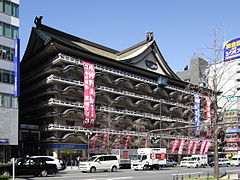Murano Tōgo
Murano Tōgo ( Japanese 村野 藤 吾 ; born May 15, 1891 in Saga Prefecture ; died November 26, 1984 ) was a Japanese architect of the Taishō and Shōwa periods .
life and work
Murano Tōgo graduated from the Department of Architecture at Waseda University in 1918 , but left the bureaucratic Tōkyō and began his career in the Kansai area. There he worked for over ten years in an architecture office that specialized in the older, eclectic style, but at the same time he was looking for a way of his own that was adapted to modern times. These efforts in his early years helped him develop the material-appropriate, mature style for which he then became known. After Murano opened his own office in 1929, he designed a series of structures that differed greatly from the main lines of the time. These works, which included the office building in Tōkyō of the Morigo Shōten company ( 盛 吾 商店 ) in 1931 and the town house of the city of Ube ( 宇 部 市 民間 Ube Shiminkan ) in 1931 , are among the most important works within modern Japanese architecture today. In 1933 Murano built the German Cultural Institute ( 独 逸 文化 研究所Doitsu Bunka Kenkyūjo ) in Kyoto at the instigation of the former Prime Minister Kiyoura Keigo and the German Ambassador Ernst Arthur Voretzsch . It was later replaced by a successor building.
In 1949 Murano merged with the architect Mori and operated as "Murano & Mori". Post-war creations include the student hall for Kansai University in 1952, the Cathedral in Memory of World Peace ( 広 島 世界 平和 記念 聖堂 Hiroshima Sekai Heiwa Kinen Seidō ) in 1953, which was awarded the Prize of the Japanese Society for Architecture ( 日本 建築 学会 Nihon Kenchiku Gakkai ), the “Nihon Seimei Hibiya Building” ( 日本 生命 日 比 谷 ビ ル ヂ ン グ ) in 1963 and the “Japan Lutheran College” ( ル ー テ ル 学院 大学 ). - Its Sukiya style residential buildings are also famous.
In 1967 Murano was honored as a person with special cultural merits and received the Order of Culture in the same year . In 1970 he became an honorary member of the American Institute of Architects , and in 1972 he received the architecture award of the Japanese Society for Architecture ( 日本 建築 学会 建築 大 賞 ) for his rest stop in the Hakone Arboretum ( 箱根 樹木園 休息 所 Hakone Jumokuen Kyūsokujo ), an ensemble of thatched roofs round huts. In 1973 Murano received an honorary doctorate from Waseda University and in 1977 a prize for the Koyama Keizō Museum of Art ( 小山 敬 三 美術館 ) in Komoro .
Murano has been active as an architect longer than any of his Japanese contemporaries. A building has been awarded the "Murano Tōgo Prize" ( 村 野藤 seit 賞 ) every year since 1988.
photos
Kashihara Railway Station, 1940
Individual evidence
literature
- Tazawa, Yutaka: Murano Tōgo . In: Biographical Dictionary of Japanese Art. Kodansha International, 1981. ISBN 0-87011-488-3 .
Web links
| personal data | |
|---|---|
| SURNAME | Murano, Tōgo |
| ALTERNATIVE NAMES | 村野 藤 吾 (Japanese) |
| BRIEF DESCRIPTION | Japanese architect |
| DATE OF BIRTH | May 15, 1891 |
| PLACE OF BIRTH | Saga prefecture |
| DATE OF DEATH | November 26, 1984 |







